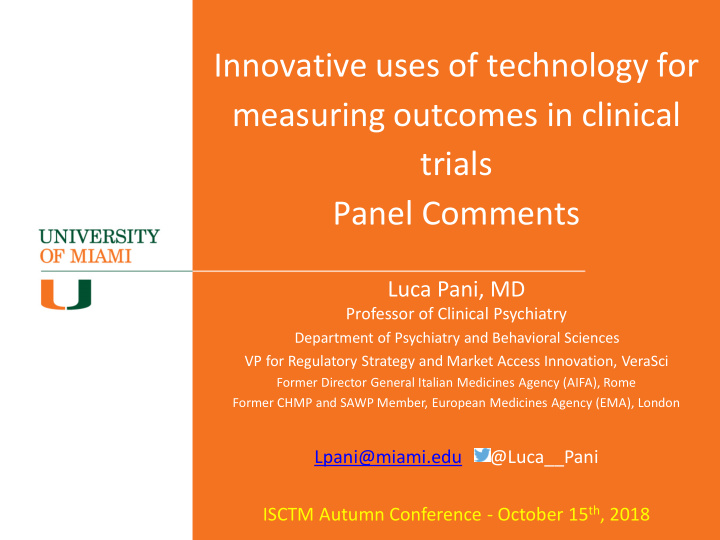



Innovative uses of technology for measuring outcomes in clinical trials Panel Comments Luca Pani, MD Professor of Clinical Psychiatry Department of Psychiatry and Behavioral Sciences VP for Regulatory Strategy and Market Access Innovation, VeraSci Former Director General Italian Medicines Agency (AIFA), Rome Former CHMP and SAWP Member, European Medicines Agency (EMA), London Lpani@miami.edu @Luca__Pani ISCTM Autumn Conference - October 15 th , 2018
Background considerations What are some of the digital biomarker considerations with regards to validation and potential for product labeling? • Like any measure, basic psychometrics and testing considerations such as Reliability • Validity • Practicality • • Data analytics, extraction, and integrity processes • Is the device measuring the construct that you think it is measuring? • Consider translational (does it fit with animal models?) • Validation and Certification of measures will be necessary for Regulators / Payers EMA could request to issue a qualification opinion and then use your biomarker to enrich a population • These surrogate and secondary endpoint measures should be linked with primary or co-primary • Product Labeling Consideration • Potential to replace Phase IV studies with patient centered outcomes (see regulatory / payer considerations above) Example-Improves social activity in people with depression •
Digital Biomarkers Regulatory Comments (1 of 3) Selecting the right device for the right endpoint • Starts with the science • Device Features • Form factor/Durability/Battery • Connectivity • Wifi/Bluetooth • Data and Metrics • Sensitive, Reliable, Clinical Relevance, Accuracy • Scalability • Deployment ease across large populations and different countries • Patient Experience • Usefulness/Burden/Adherence and technology bias
Digital Biomarkers Regulatory Comments (2 of 3) Regulators and sponsors looking for: • Better data capture • Enhanced patient experience (automation) • Efficient-Data structured for submission • Real time transparency Data Challenges • Data volume-Sponsors not equipped to receive more data from one patient actigraphy than previous entire studies • Continuous data-hard to determine a defined variable, or definite endpoint
Digital Biomarkers Regulatory Comments (3 of 3) • Biometrical subject authentication • Management of exponential increase in volume of data collected • Lack of common data standards • Consumer and even FDA approved devices could be plagued with many data reliability issues / missing data • Retention/adherence issues, subjects neglecting to wear/charge • Subject Device training and correct use monitoring without overburdening the subject • Support: Need to make sure solutions don’t require the site personnel to be “tech people” • Variability in home environments • Rate of change in consumer technology • Privacy, Legal
Reconciling Big Data and Privacy in Europe How good faith legal safeguards could de facto make Europe non competitive • The new EU General Data Protection Regulation has entered into full force on May 25 th , 2018 • Driven by the principle of data minimisation • Privacy by design and default • Right to opt out • Informed consent • Data ownership – personal / public / private • Need access to a sufficient amount of “good quality data” _____________________________________________________________
Reconciling Big Data and Privacy in Europe How good faith legal safeguards could de facto make Europe non competitive • The new EU General Data Protection Regulation has entered into full force on May 25 th , 2018 but … • Driven by the principle of data minimisation (it will preclude machine learning) • Privacy by design and default (it will preclude predictive analytics) • Right to opt out (but how? ) • Informed (really informed?) consent (impossible to predict to what I am giving consent to) • Data ownership – personal / public / private (issue is not on ownership but on access) • Need access to a sufficient amount of “good quality data” (indeed impossible with limits above) _____________________________________________________________ • EU Regulators / Payers will have these additional problems • Not enough (sometime none) competence with in-house and hands-on skills • Education of new types of assessors with very broad data science and life science knowledge. • Inability to certify and validate different data sources to be integrated among them. • Rule the emerging strong engagement by patients as data generators.
Future insights and issues New Developments • Adoption of A.I. • Machine Learning • Integration of structured and unstructured data • Applying an iterative approach • Use real life certified database for HTA as well Potential Pitfalls • Junk in / Junk out • Missing data • Unrealistic values • Not preparing the data for submission or clearly defining the objectives What we have vs. what is coming • Sensors for “activity” monitor (ok for now) • Pattern recognition (pretty cool) • Human to machine interface (very cool)
Recommend
More recommend